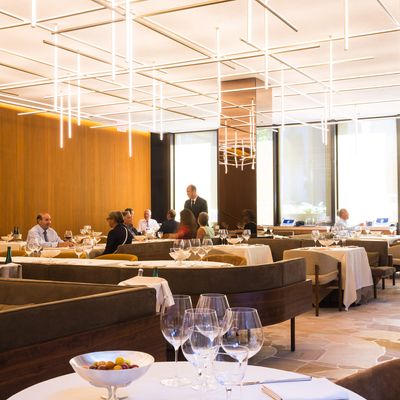
A mere ten months and $40 million after a splashy reopening, the Four Seasons restaurant will close its doors for good after lunch tomorrow. It’s a sudden, but not entirely surprising, end for the place, even though it was once the country’s most influential and — for most of its nearly 60-year run — most important restaurant. The restaurant is simply a relic of a time in which a very rich, mostly male regulars celebrated their power, and the power imbalance inherent to the culture, over lunch. Speaking to the New York Times, which broke the news of the closing, managing partner Alex von Bidder admits, “the restaurant world has changed.”
To quickly recap: Opened in 1959, the original Four Seasons occupied the landmarked Seagrams Building for 57 years and was, during that time, the sun around which power-broker planets (titans of industry, celebrities, people with big inheritances) orbited. Long story short, landlord Aby Rosen — who also tried to get rid of the restaurant’s Picasso — eventually gave owners Julian Niccolini and von Bidder the boot.
Furniture, flatware, and other pieces of the original restaurant were auctioned off; someone paid $10,000 for a set of ashtrays. The tree-motif sign went for $96,000 — not counting sales tax or a 20 percent buyer’s premium. It was a Big Deal. People, Grub included, wrote tributes and obituaries. The restaurant meant something, and its closing marked a definitive end of an era.
Alas, the splashy new restaurant, located a six minute walk from the original, never managed to feel like a new beginning. Reviews couldn’t disentangle the restaurant’s past from the new space. In The New Yorker, Hannah Goldfield wrote that what she might’ve once found “romantically retro, even thrilling,” she now saw as “dark and sad.” Even though the restaurant’s aging regulars — some of whom reportedly invested up to $1 million in the new endeavor, von Bidder tells the Wall Street Journal — filed back in, Four Seasons 2.0 never seemed to take hold with new diners. The Journal reports that “some tables were empty” on Saturday night. Von Bidder tells the Times investors pulled the plug simply because “we were not doing enough business to satisfy them.” Edgar Bronfman Jr., who is part of the family that originally opened the place, added, “we just couldn’t attract the clientele.”
The second location was conceived as a paean to the old days, and everything the Four Seasons name came to represent: power-brokering, expensive crab cakes, and VIP-only cotton candy. (The place had its quirks.) More than any other restaurant, the Four Seasons embodied the power lunch era, and all that it encompassed. Of course, the power lunch set is rapidly diminishing, and it’s hardly surprising that a new generation of diners wouldn’t, or couldn’t, create the business that the restaurant needed. (Even Esquire, which minted the very term “power lunch,” seems to recognize that the time has come to evolve away from Mad Men nostalgia. The magazine’s newly installed editor-in-chief, Michael Sebastian, tells the Journal today that he wants to get away from the idea that the magazine’s reader is “a middle-age white guy who likes brown liquor and brown leather”).
There is little glamour associated with the age that the new Four Seasons aimed to celebrate, mostly because it’s clearer than ever that it served to encourage seriously bad behavior. Niccolini himself was forced out in December, after being the face of the restaurant since 1973. He had reportedly failed to live up to an agreement to get counseling, a result of his past behavior. He was the subject of a 1992 sexual-harassment lawsuit filed by a Four Seasons waitress, and pleaded guilty to misdemeanor sexual assault in 2016. According to the Journal, von Bidder blamed the lack of crowds on “the press the restaurant received in connection” to Niccolini.
Niccolini had said in the past that he was incapable of change, and you could say the same about the Four Seasons. Its diners shaped the culture, economy, and country, but it embodied values that nobody needs to celebrate. Against all odds, the new restaurant was still a shrine to those values, but this time, New Yorkers showed they weren’t interested in kneeling at this particular altar.





